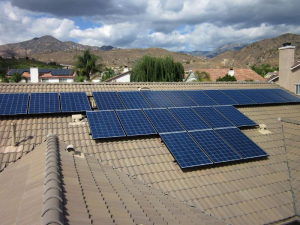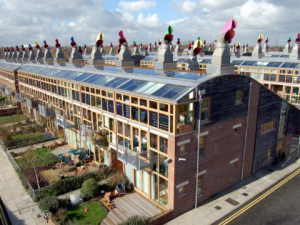April 2013 – Volume 15, Issue 7: Seared Ahi and Junior Liens
IN THIS ISSUE
Flanigan’s Eco-Logic
Obama’s First Term
New Secretary of Energy
Less Likely to Default
The Green Corps
Lancaster Mandates Solar
Cyber Attacks and Vehicles
Eco-Towns

Flanigan’s Eco-Logic: Seared Ahi and Junior Liens
EcoMotion’s last issue was opened up by more viewers than past issues, and it caused me to think: Why? What caught a spike in folks’ interest? This was the most since the Spanish travelogues in 2009.
After less-than-deep analysis, I think its food. Readers must have seen food trucks in the subject line, and then food trucks atop the stories. Forget about their energy, let’s talk seared ahi! Sure, there is a lesson here for us all. Food works. Lure ’em, bait ’em, find out what’s on their minds, engage at a visceral level! Seared Ahi, red wine, greek yogurt.
Now to junior liens: This past week, the 9th Circuit Court of Appeals dismissed a lawsuit filed by the State of California, Sonoma County, Palm Desert and others that claimed that the FHFA acted inappropriately in its directive to lenders not to purchase mortgages with PACE liens. The judge ruled that the court had no jurisdiction in the matter as FHFA had acted in its role as conservator of these enterprise organizations. Its actions did not constitute fiat as regulator, but steps as conservator to protect investments. It’s not a crippling step for PACE, but another blow. And more lenders may follow suit.
Remarkably, just days later, the University of North Carolina issued a study that found that energy-efficient homes were a third less likely to default on mortgage payments. Just as the Energy Star-rated homes in the study were more able to pay their mortgages, this would suggest that PACE liens would similarly have a positive effect, just the opposite of the court findings and subsequent ruling. Is a great financing mechanism being dismissed for the wrong reason? Despite pages and pages of testimony, the “conservator” took what it thought is the conservative approach. But perhaps this was not the conservative approach given the data. Nevertheless, the ruling stands.
There may be an answer: Junior liens.
FHFA has fought successfully against being subordinated. That’s a natural reaction, despite a history of municipal subordinating assessments. Now FHFA has had its day in court, knocking conforming loans out of the PACE business.
Back to the answer: PACE advocates have already conceded to equity requirements to qualify participating homeowners. There has to be sufficient equity in the home for PACE financing. If so, a junior lien would be equally sound for all. This is the State of Maine solution. Removing subordination removes the fight and still gets the job done. Sure, senior lien position implies a more secure investment. To “shore up” investor confidence in junior liens, Maine and Vermont have created loan-loss reserves to mitigate risks of potential investors.
Maine’s program began in 2010. Now, 100 communities that constitute 57% of the state’s population have passed ordinances providing for PACE as administered by Efficiency Maine. The program began with a $20.4 million revolving fund. Efficiency Maine provides financing up to $25,000 for 15 years at 4.99%.
Junior lien status is also successfully now employed by the states of Vermont and Oklahoma. In response to FHFA’s directives to its lenders, they “renovated” their original PACE laws with a solution that met FHFA’s needs. This solution was confirmed in a letter response from FHFA. The downside is potentially increasing the risk of defaults for local government. To counter this, borrowers in Vermont now pay 2% upfront to a loan-loss reserve, backed also by the Regional Greenhouse Gas Initiative (RGGI).
Quote of the Week
“The car is becoming a connected device.”
– Ralf Lamberti, Telematics, Daimler Research
Energy in Obama’s First Term
 SUN DAY Campaign issued an update press release on energy in the Obama years, in the President’s first term. It compares data from the December 2012 Monthly Energy Review published by the U.S. Energy Information Administration with 2008 data, the last year of the Bush administration. Renewable energy sources and natural gas expanded rapidly while coal, nuclear power, oil imports and use, energy consumption, and CO2 emissions all declined significantly.
SUN DAY Campaign issued an update press release on energy in the Obama years, in the President’s first term. It compares data from the December 2012 Monthly Energy Review published by the U.S. Energy Information Administration with 2008 data, the last year of the Bush administration. Renewable energy sources and natural gas expanded rapidly while coal, nuclear power, oil imports and use, energy consumption, and CO2 emissions all declined significantly.
Domestic energy production from renewables grew by 24% with wind and solar more than doubling in output. During the same period, nuclear power output declined by nearly 5% and domestic coal production dropped by 13%. Total energy use declined by 4%, petroleum consumption decreased by 7%, CO2 emissions dropped by 9%, and imports of crude oil and petroleum products fell by 17%.
In Obama’s first term, total domestic energy production from all sources increased by 8%. Domestic natural gas and crude oil production grew by 19% and 29% respectively. Renewable energy sources (electric and thermal) accounted for 11% of domestic energy production in 2012 compared to 10% in 2008, providing 10% more energy than nuclear power.
During the first four years of the Obama Administration, hydropower production grew by 7%, geothermal by 18%, biofuels by 41%, solar by 138%, and wind by 149%. Only biomass dipped, and by less than a percent.
Hydropower accounted for 30% of domestic energy production from renewable sources in 2012, followed by biomass (28%), biofuels (22%), wind (15%), geothermal (3%), and solar (2%). EIA data does not account for distributed, non-grid connected applications, somewhat understating solar capacity.
The Next Secretary of Energy’s Agenda

Secretary of Energy Ernest Moniz
Looking forward, President Obama’s choice for Secretary of Energy to replace Dr. Stephen Chu is Ernest Moniz, a physicist at MIT with a remarkable track record, concerning to some. He was an Under Secretary of Energy in the Clinton administration, and was more recently on President Obama’s Blue Ribbon Committee on America’s nuclear future. In the past he has called for a tripling of domestic nuclear capacity. He has deep oil and gas industry ties, and promotes increased natural gas use as the bridging fuel to a less carbon intensive future.
Scientific American reports that Moniz, like Chu, has argued for an “all of the above,” multi-pronged approach: Moniz is in favor of energy efficiency to reduce demand for power and accelerating the switch from coal to gas to reduce greenhouse gas emissions. He will encourage innovation to reduce the cost of low-carbon technologies such as renewables and nuclear power as well as accelerated deployment, and finding ways to make carbon capture and storage work, what he calls vital to growing the energy sector.
Homes a Third Less Likely to Default

Energy efficient homes keep money in owners’ pockets
A study released March 19 and called “Home Energy Efficiency and Mortgage Risks” by the University of North Carolina at Chapel Hill suggests that if you own an energy efficiency home, you are a third less likely to default on your mortgage. The report provides strong evidence that homeowners are taking savings from efficiency and paying their mortgages on time. This raises again the issue of the potential for energy-efficient mortgages, where lenders give credit for efficiency upgrades that may be more important than credit scores in issuing loans.
The study used a sample of 71,000 home loans from across the country originated between 2002 and 2012. Researchers found that mortgages on homes with Energy Star certifications were 32% less likely to default than were loans on homes with no energy-efficiency improvements. (Energy Star certified homes are up to 30% more efficient than code.)
Researchers statistically isolated factors that might account for the different performances by borrowers on their mortgages. They controlled for house size; age of the house; neighborhood income levels; house values relative to the area median; local unemployment rates; borrowers’ credit scores; loan-to-value ratios; electricity costs; and even local weather conditions. The average sale price of both the energy-efficient homes and the others was $220,000, removing the possibility that the energy-efficient properties were high-end houses purchased by families less likely to default.
Washington Post contributor Ken Harney points out that there’s the problem with the way the mortgage system treats energy efficiency: “Under current practices, you’d be hard-pressed to find any lenders who’ll give you a better rate quote on your mortgage application, even if you showed them your Energy Star certification along with documentation that your house saves buckets of money on utility bills.” These are factors that lenders and Congress should consider when making mortgage policy.
Concurrent to the release of the University of North Carolina study, the 9th Circuit Court of Appeals has vacated the district courts order and dismissed the lawsuit against the FHFA regarding PACE financing. The court ruled that the FHFA acted in its role as conservator of Freddie Mac and Fannie Mae, and thus that the courts have no jurisdiction. Similar rulings in favor of FHFA were rendered in New York and Florida, in the second and eleventh circuits. At this time, and despite over 40,000 comments, the FHFA may abandon its rulemaking process ordered by the District Court for the Northern District of California.
PACE has been seen as a game-changer for energy efficiency, especially for those with limited access to capital for efficiency upgrades and renewable energy systems. Now Freddie Mac and Fannie Mae will not purchase mortgages with superior liens, and the result will be regressive. Those that qualify for (and need) conforming loans will not be able to enjoy the benefits of energy efficiency and renewable energy system upgrades enabled through PACE that will leverage greater and greater savings over time. The ruling denies smart investments.
The Green Corps

Green Corps volunteers
The Green Corps was formed in 1992 to train future environmental and social activists. Now more than 250 have been trained, and alumni include the executive directors of Greenpeace and MoveOn.org. Thirty-five college grads are selected each year for this paid, year-long training program. It’s known as a non-profit field school for environmental organizing.
The Green Corps was formed initially by U.S. Public Interest Research Groups (PIRGs) on college campuses, reacting to post-Earth Day 1990 inertia. A new generation of leaders had to be groomed. Since its inception its campaigns have included raising awareness about global warming, exposing abuses within the bottled water industry, protecting the Arctic National Wildlife Refuge, stopping ocean dumping, protecting forests, and safeguarding fisheries.
Lancaster Mandates Solar

Lancaster will require at least 1kW for every new home
The Mayor of Lancaster is at the wheel and pushing the speed limit, driving a carbon-free initiative. His California city made history on March 26th when city council there unanimously adopted an ordinance that will require all new homes built after January 2014 to be fitted with solar systems.
A home on a 7,000 square foot lot will be required to have a minimum of 1 kW of photovoltaics. Model homes will have to display appropriate systems. “The global warming crisis will be solved by neighborhoods, not nations,” said Mayor R. Rex Parris.
Lancaster’s ordinance is flexible. Builders can aggregate solar systems on car ports or other open areas. They can also buy credits from other solar systems as long as they are within the city limits.
Lancaster is a city of 160,000 people at the northern tip of Los Angeles County. In July 2012, it was ranked number third among California cities for installed solar capacity, after San Diego and San Jose. Since then, Bakersfield and Fresno have slipped above Lancaster in the ranks
Cyber Attacks and Connected Vehicles

Technology used in the development of today’s cars
Just as we’re all getting excited about driverless vehicles, a new study by researchers at University of California at San Diego and University of Washington suggests that cars could become victims of cyber-attacks, compromising electric systems and endangering passenger safety.
Vehicles are now connected. And while far less attractive targets than banks and government databases, say researchers, individual cars may be far easier to hack. And hackers may not be motivated by financial gains, but just to prove that they can do so.
This all gives a new meaning to automotive firewalls, no longer physical. They need to protect drivers and passengers from cyber-vulnerabilities. Carmakers are now developing means to secure their vehicles from their own “infotainment” services, blue tooth systems, navigators, and soon their autonomous driving systems.
A hacker might disable the interior and exterior lights, or set the speedometer to an arbitrary speed, or engage the brakes, or disable them, trigger locks set to trap drivers in or out of their vehicles. A hacker might disable a cylinder or kill the engine, activate the airbag, or simply “adjust” the GPS.
Eco-Towns

This UK design emphasizes green homes and community
Eco-Towns began in the United Kingdom, a design competition by a government agency. To qualify as an “eco-town,” a rigorous set of criteria must be met: They must provide affordable housing (30% of units); and be zero carbon; with a minimum of 40% green space; adhere to home efficiency standards (eg. the UK’s Code for Sustainable Homes Level 4); provide for one job per housing unit that is accessible by mass transit, biking, or walking; and provide services, shops and primary schools within walking distance of every single home.
Mueller, Texas is forming an Eco-Town on a 700-acre site vacated when the Austin Airport relocated in 1999. The Eco-Town is intended to maximize sustainable living. The integrated, master-planned community will be home to 13,000 people, featuring commerce (fully 13,000 jobs), and 140 acres of open space.
A U.S. Department of Energy $10.4 million research project there is beginning to measure the impact of an influx of electric vehicles on the electricity grid. General Motors reports that Eco-Town has the highest concentration of its Volts in America. So far there are nearly 40 Volts there, plus a few Leafs, with 75 anticipated by year-end and many more to come as the community is built out.
Pecan Street Inc. a research group based at University of Texas at Austin is responsible for “heavy instrumentation” of homes. So far, 10 homes have been monitored and researchers say findings thus far are “predictable:” Unprompted, and in that absence of time of use rates, people get home and turn on the air conditioning and plug in their cars to recharge. Few are aware that AC units and EV chargers use about the same amount of power, dwarfing all other uses and taxing utility grids at peak periods. San Diego Gas & Electric does report that EV owners are more likely to have solar systems, offsetting late afternoon household demand.
